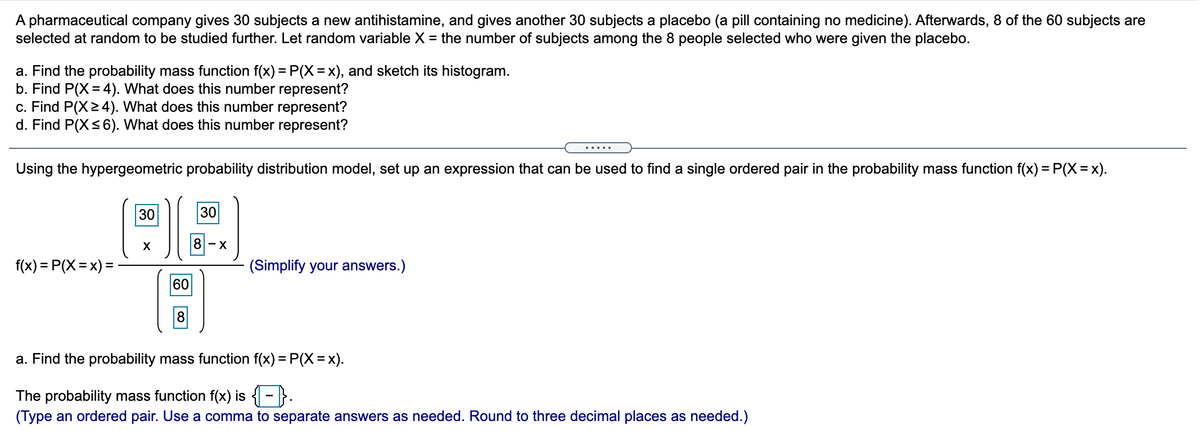A pharmaceutical company gives 30 subjects a new antihistamine, and gives another 30 subjects a placebo (a pill containing no medicine). Afterwards, 8 of the 60 subjects are selected at random to be studied further. Let random variable X = the number of subjects among the 8 people selected who were given the placebo. a. Find the probability mass function f(x) = P(X = x), and sketch its histogram. b. Find P(X = 4). What does this number represent? c. Find P(X24). What does this number represent?
A pharmaceutical company gives 30 subjects a new antihistamine, and gives another 30 subjects a placebo (a pill containing no medicine). Afterwards, 8 of the 60 subjects are selected at random to be studied further. Let random variable X = the number of subjects among the 8 people selected who were given the placebo. a. Find the probability mass function f(x) = P(X = x), and sketch its histogram. b. Find P(X = 4). What does this number represent? c. Find P(X24). What does this number represent?
Glencoe Algebra 1, Student Edition, 9780079039897, 0079039898, 2018
18th Edition
ISBN:9780079039897
Author:Carter
Publisher:Carter
Chapter10: Statistics
Section10.1: Measures Of Center
Problem 9PPS
Related questions
Question

Transcribed Image Text:A pharmaceutical company gives 30 subjects a new antihistamine, and gives another 30 subjects a placebo (a pill containing no medicine). Afterwards, 8 of the 60 subjects are
selected at random to be studied further. Let random variable X = the number of subjects among the 8 people selected who were given the placebo.
%3D
a. Find the probability mass function f(x) = P(X=x), and sketch its histogram.
b. Find P(X = 4). What does this number represent?
c. Find P(X24). What does this number represent?
d. Find P(X<6). What does this number represent?
.....
Using the hypergeometric probability distribution model, set up an expression that can be used to find a single ordered pair in the probability mass function f(x) =P(X=x).
30
30
X
8 - x
f(x) = P(X = x) =
(Simplify your answers.)
60
8
a. Find the probability mass function f(x) = P(X =x).
The probability mass function f(x) is - }.
(Type an ordered pair. Use a comma to separate answers as needed. Round to three decimal places as needed.)
Expert Solution
This question has been solved!
Explore an expertly crafted, step-by-step solution for a thorough understanding of key concepts.
This is a popular solution!
Trending now
This is a popular solution!
Step by step
Solved in 4 steps with 15 images

Recommended textbooks for you

Glencoe Algebra 1, Student Edition, 9780079039897…
Algebra
ISBN:
9780079039897
Author:
Carter
Publisher:
McGraw Hill

Glencoe Algebra 1, Student Edition, 9780079039897…
Algebra
ISBN:
9780079039897
Author:
Carter
Publisher:
McGraw Hill